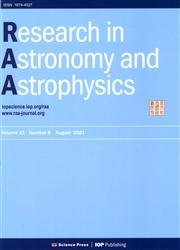A Hierarchical Method for Locating the Interferometric Fringes of Celestial Sources in the Visibility Data
IF 2.8
4区 物理与天体物理
Q3 ASTRONOMY & ASTROPHYSICS
引用次数: 0
Abstract
Abstract In celestial source detection in Tianlai project, locating interferometric fringe in visibility data accurately will influence downstream tasks drastically, such as physical parameters estimation and weak celestial source exploration. Considering that traditional locating methods are time-consuming and supervised methods require a great quantity of expensive labeled data, in this paper, we firstly investigate characteristic of interferometric fringes in simulation and real scenario respectively, and integrate almost parameter-free unsupervised clustering method and seeding filling or eraser algorithm to propose a hierarchical plug and play method to improve locating accuracy. Then, we apply our method to locate single and multiple sources' interferometric fringes in simulation data. Next, we apply our method in real data taken from Tianlai radio telescope array. Finally, we do comparison with unsupervised methods of state of the art. These results show that our method has robustness in different scenarios and can improve locating measurement accuracy effectively.能见度数据中天体干涉条纹的分层定位方法
在天来工程天体探测中,能否准确定位能见度数据中的干涉条纹,将对物理参数估计和弱天体探测等后续任务产生重大影响。针对传统的干涉条纹定位方法耗时长、需要大量昂贵的标记数据等问题,本文首先研究了干涉条纹在模拟场景和真实场景下的特征,结合几乎无参数的无监督聚类方法和播种填充或擦除算法,提出了一种分层即插即用的方法来提高定位精度。然后,应用该方法对模拟数据中的单源和多源干涉条纹进行定位。然后,将该方法应用于天来射电望远镜阵列的实际数据。最后,我们对目前的无监督方法进行了比较。结果表明,该方法在不同场景下均具有鲁棒性,能有效提高定位测量精度。
本文章由计算机程序翻译,如有差异,请以英文原文为准。
求助全文
约1分钟内获得全文
求助全文
来源期刊

Research in Astronomy and Astrophysics
地学天文-天文与天体物理
CiteScore
3.20
自引率
16.70%
发文量
2599
审稿时长
6.0 months
期刊介绍:
Research in Astronomy and Astrophysics (RAA) is an international journal publishing original research papers and reviews across all branches of astronomy and astrophysics, with a particular interest in the following topics:
-large-scale structure of universe formation and evolution of galaxies-
high-energy and cataclysmic processes in astrophysics-
formation and evolution of stars-
astrogeodynamics-
solar magnetic activity and heliogeospace environments-
dynamics of celestial bodies in the solar system and artificial bodies-
space observation and exploration-
new astronomical techniques and methods
 求助内容:
求助内容: 应助结果提醒方式:
应助结果提醒方式:


